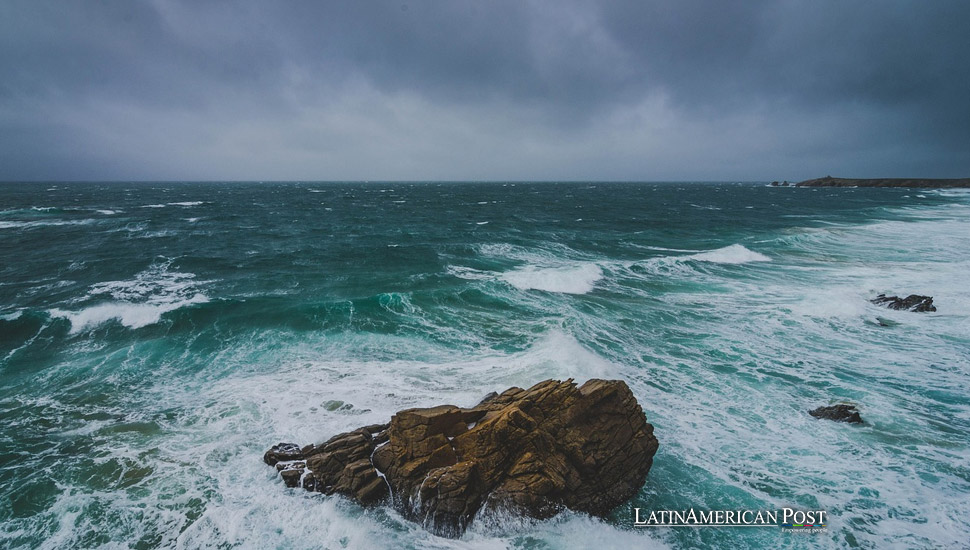The Looming Collapse of Atlantic Ocean Currents and What It Means for Latin America

As scientists warn of the potential collapse of the Atlantic Meridional Overturning Circulation (AMOC), Latin America faces devastating impacts. This critical ocean system could dramatically alter the region’s future from rising sea levels to ecological shifts in the Amazon.
Understanding the AMOC
The Atlantic Meridional Overturning Circulation (AMOC) is one of the most crucial systems driving the Earth’s climate, often called the ‘great ocean conveyor.’ Acting as a colossal river within the ocean, it moves warm, salty water from the tropics toward the North Atlantic, where it cools, sinks, and flows back southward at deeper levels. This process plays an essential role in regulating temperatures, particularly in the Northern Hemisphere, and it significantly influences global weather patterns, including those in Latin America. If the AMOC weakens or collapses, the repercussions for the region could be severe, leading to dramatic changes in the environment, economies, and societies.
AMOC and Its Global Importance
The AMOC transports around 25% of the total heat that flows into the Northern Hemisphere, which helps prevent the spread of Arctic sea ice and maintains the relatively mild climate experienced in Northern Europe. However, the AMOC’s importance is not limited to Europe. It also influences weather patterns across the Atlantic, impacting rainfall, temperature, and American sea levels. This system is a cornerstone of the global climate, and its disruption would lead to changes that reverberate far beyond the Atlantic Ocean.
Scientists have been increasingly concerned about the stability of the AMOC, especially in the context of global warming. Rising temperatures in the North Atlantic are causing the surface waters to become fresher due to melting ice and increased rainfall, which weakens the density of the water and prevents it from sinking as it once did. This, in turn, slows down the entire AMOC system, which is already showing signs of weakening.
If the AMOC were to collapse, the consequences could be catastrophic. The disruption of this oceanic conveyor belt would lead to drastic changes in weather patterns, shifting climate zones, altering rainfall, and increasing the frequency and severity of extreme weather events. Scientists predict that the AMOC could weaken by as much as 30-50% by the end of the century if current trends in greenhouse gas emissions continue, with profound effects on local and global climates.
Potential Consequences for Latin America
For Latin America, the collapse of the AMOC would be a disaster on multiple fronts. One of the most immediate consequences would be changes in rainfall patterns. The Amazon rainforest, a vital ecosystem for the planet, depends on regular rainfall to sustain its biodiversity. A weakened AMOC could cause the rainy season in the Amazon to shift or even fail altogether, leading to severe droughts that could devastate the forest. This, in turn, would accelerate deforestation, reduce the forest’s ability to absorb carbon dioxide and contribute to further global warming.
In addition to ecological impacts, changes in rainfall patterns would also affect agriculture across Latin America. Countries such as Brazil, Argentina, and Colombia, which rely heavily on agriculture for domestic consumption and export, would face significant challenges. Shifts in weather patterns could lead to crop failures, food shortages, and economic instability. Farmers who depend on predictable growing seasons would find it increasingly difficult to maintain their livelihoods, exacerbating poverty and inequality in rural areas.
The AMOC collapse would also lead to rising sea levels along the eastern coasts of North and South America. Coastal cities in Latin America, such as Buenos Aires, Rio de Janeiro, and Lima, would be particularly vulnerable to flooding. Rising sea levels and more frequent and intense storms would threaten infrastructure, displace millions of people, and put enormous pressure on governments to manage the resulting humanitarian crises. The financial cost of adapting to rising seas, building seawalls, and relocating vulnerable populations would be immense, stretching already strained public resources.
Latin American countries that depend on fishing would face further challenges. The disruption of ocean currents would affect marine ecosystems, altering the distribution of fish species and potentially leading to fisheries collapsing. Countries like Peru, which rely heavily on the Humboldt Current for their fisheries, could see dramatic declines in fish stocks. This would impact the economy and the food security of millions of people who depend on fish as a primary source of protein.
Latin American Countries at Risk
While all of Latin America would be affected by the collapse of the AMOC, some countries would be more vulnerable than others due to their geography, economy, and reliance on natural resources.
Brazil, home to the Amazon rainforest, would be one of the hardest-hit countries. The Amazon plays a critical role in regulating the global climate by absorbing carbon dioxide, and its destruction would have dire consequences for global warming. Moreover, Brazil’s agricultural sector, one of the largest in the world, would be severely impacted by changes in rainfall patterns. Droughts and floods would become more common, threatening food production and exacerbating existing social inequalities.
Mexico is another country at significant risk. Already prone to hurricanes, Mexico could see an increase in the frequency and intensity of storms, particularly along its Gulf Coast. Rising sea levels would threaten coastal cities like Cancun and Veracruz, while droughts in the northern part of the country could lead to water shortages and increased desertification. The combination of more intense storms and prolonged droughts would strain the country’s economy and infrastructure.
The Caribbean nations, including Cuba, Haiti, and the Dominican Republic, would also face significant challenges. These small island nations are already vulnerable to sea-level rise, and the collapse of the AMOC would exacerbate the problem. More frequent and powerful hurricanes would devastate their economies, which rely heavily on tourism and agriculture. The increased cost of rebuilding after natural disasters and the loss of tourism revenue could push these countries into an economic crisis.
Argentina, with its vast coastline, is also at risk. Rising sea levels would threaten Buenos Aires, one of the largest cities in South America, while rainfall patterns could affect the Pampas region, the country’s agricultural heartland. Argentina is one of the world’s largest exporters of beef and grains, and any disruption to its agricultural sector would have far-reaching consequences for the global food supply.
Peru, which depends heavily on its fishing industry, could see a collapse in fish stocks as ocean currents shift and marine ecosystems are disrupted. The Humboldt Current, which brings nutrient-rich waters to the coast of Peru, supports one of the most productive fisheries in the world. A weakened or collapsed AMOC would alter the current, leading to declines in fish populations and threatening the livelihoods of thousands of people who depend on the fishing industry.
What Can Be Done to Mitigate the Threat?
The collapse of the AMOC is directly linked to global warming, and the most effective way to prevent it is to reduce greenhouse gas emissions. Latin American countries have already made some progress in this area, with many investing in renewable energy sources such as wind, solar, and hydropower. However, much more must be done to curb emissions and transition to a sustainable, low-carbon economy.
In addition to reducing emissions, Latin American countries must invest in climate resilience. This means building infrastructure that can withstand rising sea levels and more frequent natural disasters. Coastal cities must invest in seawalls and flood defenses, while rural areas must improve water management systems to cope with changing rainfall patterns. Governments must also implement policies promoting sustainable agriculture and protecting natural ecosystems, such as the Amazon rainforest, which is crucial in regulating the climate.
International cooperation is also essential in addressing the AMOC threat. Latin American countries must work with the international community to monitor changes in the AMOC and develop strategies to mitigate its impact. The region’s leaders should push for more decisive climate action at global forums, such as the United Nations Climate Change Conference, and advocate for more significant financial support for developing countries most vulnerable to climate change.
The potential collapse of the AMOC presents an existential threat to Latin America. The region’s ecosystems, economies, and societies are all at risk if this vital oceanic system weakens or collapses. Immediate action is needed to reduce greenhouse gas emissions and build resilience to the inevitable climate changes that will occur. While the situation is dire, there is still time to act – but the window is closing fast.
Also read: Mexico’s Green Hydrogen Ambitions and Latin America’s Path to Decarbonization
The future of Latin America depends on its ability to adapt to the challenges posed by climate change, and the collapse of the AMOC would be one of the most severe consequences of this global crisis. Suppose Latin America can lead the way in reducing emissions and building climate resilience. In that case, it will protect its people and environment and set an example for the rest of the world.




